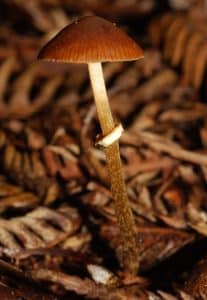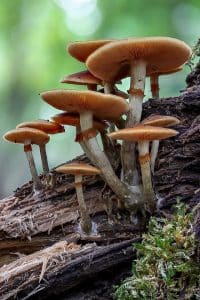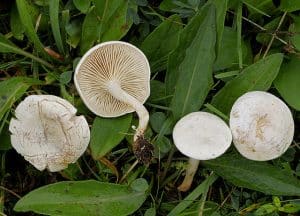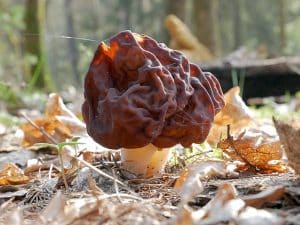There are a lot of wild mushrooms that are considered inedible and even toxic. But a few may be lethal if consumed in sufficient quantities–and sometimes those quantities aren’t very much. Here are some of the species you’ll most want to avoid when foraging for mushrooms; as the common names suggest, these are nothing to mess around with!

Deadly Amanitas
If you want to be a cautious mushroom hunter, avoid big white mushrooms, at least until you feel more confident in your identification skills. You may have to skip edible matsutakes (Tricholoma spp.), but you’ll also keep yourself safe from death caps and destroying angels.
The death cap (Amanita phalloides) can be found on both coasts of North America, though it’s native to Europe. It is a large white gilled mushroom that sometimes has a yellowish or greenish tint on the upper side of the cap. It often has a pronounced annulus (ring) and volva (cup) on the stipe, which may also have a lightly scaled texture. It’s thought that a half a cap is enough to kill an adult.
The name destroying angel is applied to several large white Amanita species; in North America A. bisporigera is found in the east, while A. ocreata grows in the west. It is often all white, though the cap may have a light yellow or pink tint, and the stipe frequently displays a pronounced volva.
When young, these Amanita species often look like a small, white ball, much like the edible puffball mushrooms. However, where the puffball is solid all the way through, Amanitas have a little depression where the stipe and gills are beginning to form. The amatoxins and phallotoxins in these deadly mushrooms can cause gastrointestinal distress within a few hours of consumption, but it’s the damage they do to your liver and kidneys in the weeks after that can be fatal. Many who have consumed these mushrooms needed organ transplants to live.

Common Conecap
This is one of many “little brown mushrooms”, any of a number of small, rather nondescript brown gilled mushrooms that at first glance look very similar to each other. However, Pholiotina rugosa (formerly known as Conocybe filaris) is highly toxic, unlike most LBMs. The specific toxin in this mushroom is alpha-amanitin, which will cause the liver to shut down; this toxin is also found in the deadly Amanitas.
Common conecap has a small brown cap with a convex shape and a small bump (umbo) in the center; the cap rarely gets much more than an inch or so across. It has a very slender stipe which is pale and smooth near the cap, turning brown and scaly further down, though the ratio of white to brown may vary. It also frequently has an annulus (ring) around the stipe which may be moved up and down; however, because this ring is fragile and may be damaged or missing its absence should not rule out an identification of P. rugosa.
It often grows in meadows and lawns, and is found on the west coast, and scattered throughout eastern North America in temperate areas. It looks quite a bit like Psilocybin species, and this mistaken identity is the cause for many conecap poisonings. Psilocybins do not have the ring around the stipe, though, and many of them stain blue when damaged, while conecap does not stain. Spore prints may not be a reliable way for a beginner to differentiate species, as common conecap has reddish brown to brown spores, and Psilocybin species tend to have varying shades of brown spores.

Deadly Galerina/Funeral Bell
Another poisonous LBM, the deadly galerina (Galerina marginata) also shares some of the same amatoxins as the Amanitas, specifically α-amanitin, β-amanitin and γ-amanitin. It is a small mushroom that rarely reaches two inches in diameter and three inches tall. When young, the edges of the cap may be turned under, but it flattens out with age and may develop an umbo, or small bump, in the center. It is a fairly nondescript medium brown in color, and the stipe is slender and various shades of brown with a vertically striated texture. The stipe may also have a pronounced ring, though this may have fallen off of some specimens. The gills are pale brown when young, darkening with age; some of the gills may fork closer to the edge of the cap. Even the spore print is a rather unremarkable brown.
Deadly galerina’s preferred substrate is decaying wood, particularly of conifers. This makes it even more likely to be confused with edible honey mushrooms, which are also LBMS that grow on decaying trees, to include conifers. It grows commonly east of the Great Plains, and along the west coast, with scattered sightings in the Rockies.

Fool’s Funnel
This small white mushroom, as its common name suggests, does have a rather funnel shaped appearance. For all its innocuous looks, though, Clitocybe rivulosa has enough muscarine in it to be deadly in sufficient quantities. They appear on lawns and other open grassy areas where they may be accidentally eaten by children or pets. They also resemble the edible Clitopilus prunulus, which has a pink spore print contrasted with the fool’s funnel’s white spores.
When young, the cap is pale brown with a frost of white over it, before turning white with maturity. As the mushroom ages it gets circular brown cracks on top of the cap. The white gills under the cap are quite prominent, and extend slightly down the slender stipe, and the stipe does not have a ring. It is scattered throughout North America.

Gyromitra
This mushroom carries a great deal of controversy. There are several species in the genus Gyromitra that have the carcinogenic toxin gyromitrin, particularly (but not limited to) the false morel (G. brunnea) and elfin saddle (G. infula). When consumed, it may affect the liver, kidneys, and nervous system. It is unstable and can be converted to monomethylhydrazine which also attacks the liver, kidneys, and central nervous system, and can be fatal. Even if immediate death is avoided, gyromitrin may build up in the body over time and cause cancer, as has been demonstrated in lab animals that have consumed small amount of this compound. Symptoms may include hemolysis, methemoglobinemia, kidney and liver failure, seizures and more. Parboiling or other cooking is not sufficiently consistent in removing gyromitrin, and so Gyromitra species should be considered as potentially lethal poisonous mushrooms.
While looking superficially like the edible morels (Morchella spp.), false morels look less like honeycombed cones, and more like brains or piles of worms. Where morels are entirely hollow inside, false morels are solid, or have a series of fleshy chambers as opposed to one uniform hollow. They may be varying shades of brown, gray, purple, and even black, usually with a pale stipe, and are usually only a few inches tall. The spore color varies by species.
—————
Written by Rebecca Lexa
Rebecca Lexa is a certified Master Naturalist in the Pacific Northwest. She teaches classes on foraging and other natural history topics, both online and off. More about her work can be found at http://www.rebeccalexa.com.
Many of our readers find that subscribing to Eat The Planet is the best way to make sure they don't miss any of our valuable information about wild edibles.
See our privacy policy for more information about ads on this site







One Response
Thank you for sharing your knowledge